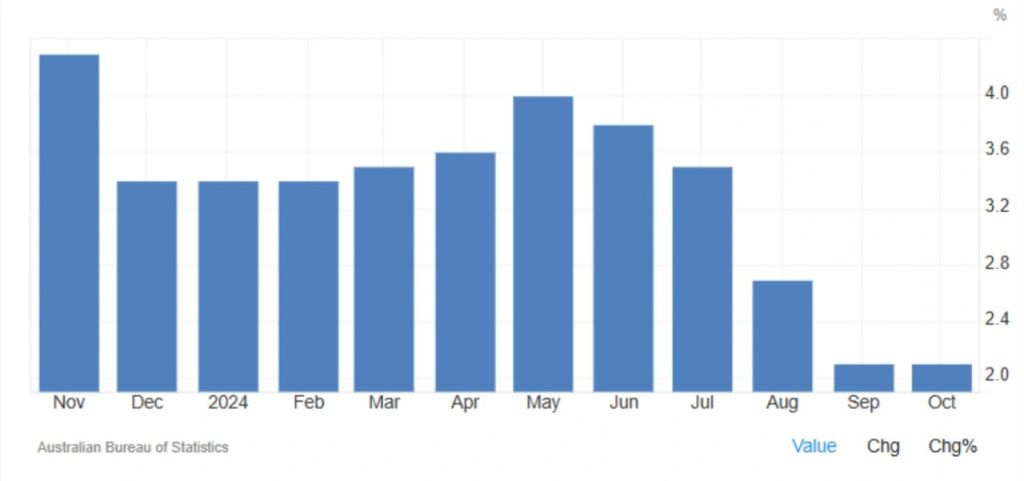
Australia’s CPI Shows Steady Growth in October 2024
Australia’s Consumer Price Index (CPI) rose by 2.1% year-on-year in October 2024, marking a consistent level of inflation for the second consecutive month. This result, however, was slightly lower than the market expectation of 2.3%. Despite this miss, the CPI remains at its lowest point since July 2021, staying within the Reserve Bank of Australia’s target range of 2-3% for the third straight month. The persistence of inflation at this rate suggests that the economic recovery remains on track, aided by factors such as the Energy Bill Relief Fund, which continues to soften the impact of rising prices.

Energy Prices Keep Inflation in Check
A key factor in this relatively mild inflation rate is the continued decrease in energy prices. In particular, electricity prices dropped by a record 35.6% in October 2024, compared to a 24.1% reduction the month before. This decline has been attributed to the government’s ongoing Energy Bill Relief Fund, which has been effective in reducing household energy costs. Additionally, automotive fuel prices continued their downward trend, falling 11.5% in October. While this is a smaller drop compared to the 14.0% decrease in September, it still marks a significant relief for Australian households facing high fuel costs.
These energy-related price reductions have had a substantial effect on keeping the overall CPI from rising more sharply. Energy is a major component of the CPI, and as such, fluctuations in this sector can significantly impact the broader inflation picture. The fall in electricity and fuel prices helped offset price increases in other sectors, providing a balancing effect on the overall inflation rate.
Rising Prices in Key Sectors
While energy prices have seen dramatic decreases, other essential goods and services have experienced continued price hikes. Food prices remained high, rising by 3.3% in October, consistent with the previous month. This marks an ongoing trend in food price inflation, which has been driven by factors such as supply chain disruptions and increased costs for raw materials. Similarly, alcohol and tobacco prices increased by 6.0%, slightly easing from the 6.3% rise seen in September.
Health and education costs also showed steady increases. Health services saw a 3.9% rise, down from 4.8% in September, while education costs remained high with a 6.3% increase, only slightly lower than the 6.4% rise the previous month. These price pressures in essential sectors contribute to the overall cost of living, which continues to affect Australian households despite the broader stabilization in inflation.
Furthermore, recreation and cultural services experienced a notable increase of 4.3%, up from 2.4% in September. This could be attributed to rising costs in leisure and tourism-related activities, which have seen greater demand as the economy recovers from the impacts of the pandemic. These continued price increases in non-energy sectors indicate that inflationary pressures are not entirely under control, especially in everyday goods and services.
Core CPI Slows Down, Suggesting Moderation
Looking beyond the volatility of food and energy prices, the core CPI, which excludes these categories, showed a more modest rise of 2.4% in October. This represents a slowdown from the 2.7% increase seen in September, marking the lowest core inflation rate since November 2021. The moderation in core CPI suggests that while inflation is still present, it may be easing in certain areas of the economy. The lower core inflation rate is a positive sign, as it indicates that price increases outside of volatile sectors are not accelerating at the same pace as they were earlier in the year.
The core CPI is an important indicator for policymakers, as it gives a clearer picture of underlying inflation trends. With the core inflation rate easing, the Reserve Bank of Australia may have more flexibility in adjusting monetary policy if needed. For now, the steady CPI and core CPI readings suggest that inflationary pressures are stabilizing, giving Australian consumers and businesses some breathing room.
Conclusion: A Balancing Act Between Energy Relief and Rising Costs
Australia’s CPI report for October 2024 reveals a balancing act between the relief provided by falling energy prices and the persistent price increases in other sectors. While the Energy Bill Relief Fund has helped keep overall inflation in check, sectors like food, health, and education continue to experience price hikes. The moderate core CPI suggests that inflation is stabilizing, but ongoing challenges in key areas mean that the cost of living remains a concern for many Australians. As the year progresses, the outlook for inflation will depend on how energy prices continue to evolve and whether other sectors can follow suit in easing their price pressures.
Share
Hot topics

Federal Reserve’s Challenges to Trump’s New Policies
As the Federal Reserve Open Market Committee (FOMC) prepares for its upcoming meeting, all eyes are on how the Fed will respond to Donald Trump’s latest economic policies. With the...
Read more




Submit comment
Your email address will not be published. Required fields are marked *